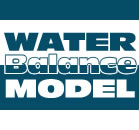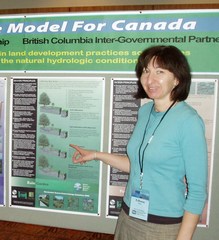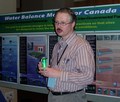Calgary Contributes Funds to Enhance Water Balance Model

The City of Calgary has made an initial contribution of $10,000 towards development of the Water Balance Model for Canada. Under the terms of a Memorandum of Understanding with the BC-based Inter-Governmental Partnership that is leading this inter-provincial initiative, the City’s contribution was made on behalf of the Alberta Low Impact Development Partnership (ALIDP). The cities of Calgary and Edmonton co-chair ALIDP.
According to the City’s Paul Fesko (Manager, Strategic Services, Water Resources), “The City of Calgary is pleased to be able to take this important step in bringing the Water Balance Model to local governments and practitioners in Alberta. Because it is very much an on-the-ground tool in its application, we anticipate that this tool will help everyone do a better job of designing with nature to achieve water sustainability objectives.”
In reflecting on how the inter-provincial partnership is taking shape, Fesko observed that: “Looking back, it was September 2004 when I met Kim Stephens of the British Columbia partnership at the initial meeting of the group of Alberta agencies that subsequently formed ALIDP. When Kim did an online demonstration of the Water Balance Model, my immediate reaction was that this is a powerful tool for social marketing.”

Paul represents the City of Calgary on the Bow River Basin Council and has been part of the Natural Environment Working Group for Imagine Calgary, a project to develop a long-range vision of a sustainable Calgary. Application of the Water Balance Model dovetails with both, he says.
Alberta Low Impact Development Partnership
ALIDP is comprised of municipal and provincial governments, provincial agencies, and non-profit organizations that have a stake in promoting improvements in land development practices so that degradation of the natural environment is prevented or reduced.
 According to Liliana Bozic (City of Calgary), speaking on behalf of ALIDP: “The partnership's mission is to protect and maintain the integrity of the natural environment while promoting the growth and prosperity of Alberta's urban centres. Our #1 goal is to facilitate the development of a ‘Made in Alberta' LID strategy that is consistent with and achieves the desired outcomes of the Province's Water for Life initiative.” For more on ALIDP, please click here.
According to Liliana Bozic (City of Calgary), speaking on behalf of ALIDP: “The partnership's mission is to protect and maintain the integrity of the natural environment while promoting the growth and prosperity of Alberta's urban centres. Our #1 goal is to facilitate the development of a ‘Made in Alberta' LID strategy that is consistent with and achieves the desired outcomes of the Province's Water for Life initiative.” For more on ALIDP, please click here.
British Columbia Partnership
The BC-based Inter-Governmental Partnership (IGP) draws its strength from local government and is a consortium of local governments and regional, provincial and federal agencies. Formed in July 2002, it began as a subgroup of an inter-agency technical committee of the Greater Vancouver Regional District. The IGP quickly expanded to become a provincial group with municipal representation from four regions of British Columbia: Greater Vancouver, the Fraser Valley, Vancouver Island and the Okangan Valley. It is co-chaired by the BC Ministry of Agriculture & Lands and Environment Canada. Funding from Canada Mortgage & Housing Corporation enabled development of a national portal. For the complete story on the national initiative, please click here.
 According to Ted van der Gulik, IGP Chair, “The contribution by Calgary will help fund the next leap forward in the evolution of the Water Balance Model. By that I am referring to our plan to provide the engineering community with ‘one-stop shopping’ by merging the WBM with QUALHYMO. While the WBM demonstrates how to achieve a light hydrologic footprint, drainage engineers want to simulate what happens to overflows once source controls have reached capacity during sustained wet weather periods.” For more on this plan, please click here.
According to Ted van der Gulik, IGP Chair, “The contribution by Calgary will help fund the next leap forward in the evolution of the Water Balance Model. By that I am referring to our plan to provide the engineering community with ‘one-stop shopping’ by merging the WBM with QUALHYMO. While the WBM demonstrates how to achieve a light hydrologic footprint, drainage engineers want to simulate what happens to overflows once source controls have reached capacity during sustained wet weather periods.” For more on this plan, please click here.
QUALHYMO is a rainfall-runoff model originally developed in Ottawa by Dr. Charles Rowney in the 1980s, with funding from the Ontario Ministry of Environment, to assess the water quality in the Rideau Canal. The validation of the engine has already been done and the model is a proven piece of software. “By merging the two tools, engineers will be able to hydraulically model the storage and routing of outflows from a subdivision and/or neighbourhood through a detention pond or down a stream channel. They will also be able to assess water quality,” noted van der Gulik.
Next Steps
“The next steps for this inter-provincial partnership will be to focus on how the enhanced Water Balance Model can be implemented in Alberta. The ALIDP will also continue working with local and provincial government representatives, developers and water management consultants in profiling the Water Balance Model in Alberta and seeking partnership members and funding to ensure this planning tool becomes a successful addition to land use planning strategies in Alberta”, reports Liliana Bozic, ALIDP Co-Chair.
In October, ALIDP and the IGP are collaborating to conduct a Water Balance Model Workshop in conjunction with the Cochrane LID Conference. “We are  excited that the team of Kim Stephens, Doug Backhouse and Richard Boase from British Columbia will be doing an online demonstration of this tool. The Cochrane Conference will provide Albertans with an opportunity to see this entertaining team in action. Kim, Doug and Richard provide value because of the way they engage and interact with their audiences”, says Bert van Duin, a member of the ALIDP Steering Committee. .For conference details, please click here.
excited that the team of Kim Stephens, Doug Backhouse and Richard Boase from British Columbia will be doing an online demonstration of this tool. The Cochrane Conference will provide Albertans with an opportunity to see this entertaining team in action. Kim, Doug and Richard provide value because of the way they engage and interact with their audiences”, says Bert van Duin, a member of the ALIDP Steering Committee. .For conference details, please click here.
According to Kim Stephens, Project Coordinator for the IGP, “We are looking forward to meeting with our Alberta colleagues in Cochrane. Because the workshop will be a half-day event, we are designing it as an online 'show-and-tell'  demonstration of the Water Balance Model. We hope that this will create interest in taking hands-on training in a computer lab as a workshop outcome. At Cochrane, we wil be engaging the audience with what we call the 'Design with Nature Gameshow'. We have found that this is a powerful way to educate practitioners about the benefits of the water balance way-of-thinking.”
demonstration of the Water Balance Model. We hope that this will create interest in taking hands-on training in a computer lab as a workshop outcome. At Cochrane, we wil be engaging the audience with what we call the 'Design with Nature Gameshow'. We have found that this is a powerful way to educate practitioners about the benefits of the water balance way-of-thinking.”
Posted August 2006

